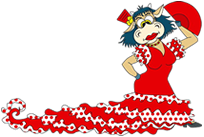"Soleares" (a simpler version of "soleá") is one of the most basic forms or "palos" of Flamenco music, probably originated around Cádiz or Seville in Andalusia, the most southern region of Spain. It is normally accompanied by one guitar only, in the key of E phrygian, although relatively often it is also heard in A phrygian.
When singers sing soleá, as with most palos, they normally choose different stanzas, with different melody, and combine them according to the inspiration of the moment or to a previous plan. Even if the singer has a previous plan, he often alters it on the spur of the moment. These stanzas are independent in subject matter from one another.
The content of the lyrics is generally serious in nature, as appropriate to the solemn air of the music. They often have a sententious tone and convey a feeling of intimate pain. Sometimes despair, more typical of seguiriya, can also appear. However, it is difficult to generalize: sometimes a less serious stanza can turn up in the middle of other serious ones, and irony is frequent.
The stanza of the soleá has three or four lines. In four-line stanzas, the second and fourth line are in assonant rhyme, while the first and second are free. In three-line stanzas, the assonance is between the first and the third.
Soleá is one of the flamenco palos with the highest number of traditional songs, and it is particularly appreciated by knowledgeable artists and audiences. It is very demanding for singers, as they have to strive to be creative and, at the same time, respectful of the tradition, and they have to succeed in finding a good balance between melodic and rhythmic sides, both extremely difficult. It demands great vocal faculties, and the singer should achieve a balance between passion and restraint.
The melody of a soleá stanza usually stays within a limited range (usually not more than a 5th). Its difficulty lies in the use of melisma and microtones, which demand great agility in the voice. It is usual to start a series of soleares with a more restrained stanza in the low register, while continuing to more and more demanding styles. The series is quite often finished with a stanza in a much more vivid tempo in Major mode.
The metre or "compás" of the soleá of the is one of the most widely used in Flamenco. Other palos have derived their compás from the soleá, including Bulerías por soleá, the palos in the Cantiñas group, like Alegrías, Romeras, Mirabrás, Caracoles or, to a certain extent, Bulerías. It consists of 12 beats. However, the distribution of strong and weak beats totally differs from the 12 beat metres used in classical music. Instead, it could be described as a combination of triple and duple beat bars, so it's a polymetre form. However, strong beats are at the end of each bar, instead of at the beginning (as it would be normal in Western music).
Soléa develops in Phrygian mode. To symplify, we could say it is traditionally played in E Phrygian (often also in A Phrygian). To adapt to the pitch of the singer, guitarists can use a capo, so that they can play in other keys preserving the traditional chord positions. Modern guitarists, though, often play soleá using other chord positions or even changing the tuning of the guitar to experiment with new sounds, especially in solo instrumental pieces.
The typical flamenco progression A minor, G, F, E (called Andalusian progression) is heard several times during the development of the song.
Soleá guitar style is easily identified by its metre and Phrygian mode, but also by a series of characteristic strummings and phrases which are heard several times, called "llamadas", with multiple variations, along a song or solo piece. A modern guitarist, when playing soleá, will combine longer musical fragments called "falsetas" with these characteristic strummings and phrases, which are used to mark the beginning and end of the falsetas and to show the singer (if there is one) that the falseta is over and he can start singing.
When a guitarist plays in E key, he is said to play "por arriba" ("up"), while, if he plays in A phrygian, he is said to play "por medio" ("in the middle"). The reason for this is that most flamenco singers and guitarists do not usually have any formal musical training: they cannot identify the key, but only the position of the fingers.
Soleá guitar playing is extremely rich in techniques and rhythmic play. This has made it a favourite among solo concert guitarists. Among the guitarists that have excelled in this "palo" for solo concert are Ramón Montoya, Sabicas, Paco de Lucía, Gerardo Núñez and Rafael Riqueni.
The origins of this "palo", as it happens in fact with most "palos", is very much in the dark, and has been subject to much unproved speculation. In spite of being one of the most prestigious "palos", the soleá is considered to be relatively new compared to Tonás and Seguiriyas. The earliest known mention of them, referred to as "soledades", is that of Spanish poet Gustavo Adolfo Bécquer, in 1862. The existence of them prior to 1850 is often stated, but has never been proved. Folklorist Demófilo assured, as early as 1879, that they derived from the "coplas de jaleo", a kind festive song style in a very lively rhythm, apparently very popular in the mid 19th century. These facts contradict other views according to which the soleá would be the origin of the rest of flamenco "palos" and was from the beginning a serious and solemn style. In their primitive stages, soléa, as well as jaleo, seem to have been linked to Gypsy environments in several towns of the provinces of Cádiz and Seville.
The golden age of the soleá is considered to be the last quarter of the 19th century, at the time when the "café cantante" (musical café) was the preferential venue for flamenco artists. Most of the soleá melodies we know have been attributed to singers who were active at that time. With the turn of the century, other "palos" like those belonging to the group "cantes libres" like malagueña, tarantas, or Cartageneras took the supremacy. At the times of the "Ópera Flamenca", it was further displace by Fandangos, popular songs fashioned to the Bulerías rhythm and "cantes de ida y vuelta" like the Guajiras.
During the 50s-70s, at the time of the neo-traditionalism of Antonio Mairena and his school, the style went back into favour, becoming, together with Seguiriyas and Tonás one of the most valued by flamenco artists, critics and public. The soleá went again into disfavour after the birth of New Flamenco. Followers of Camarón de la Isla and his school tend to pay less attention to traditional, "hard" styles, and favour other more festive "palos" like Bulerías or tangos, which are easier to mix with pop and commercial music influences.












